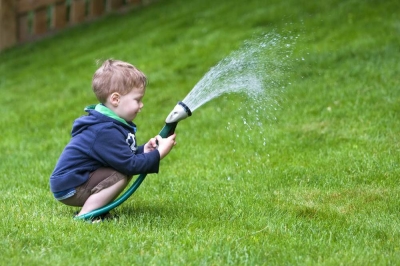Stop Wasting Water and Money. FIND A LOCAL PRO
Salt-based Water Softener
How a salt-based water softener is built and how it works.
Our salt-based water softeners use ion exchange to soften the water. The system consists of a pressure base tank, filled with sulfonated polystyrene beads that are capable of removing hardness from water and replacing it with softer ions such as sodium. This tank is connected to a brine tank that is filled with salt.

Hard water enters the pressure base tank and washes over the beads. This process pulls out the hard elements,like magnesium and calcium, and replaces them with sodium. Softened water then leaves the tank and is ready to be used in the home.

When the water washes over the beads (also referred to as resin), the magnesium, calcium, and iron are captured by the resin and replaced with sodium.



After some time, the beads will not be able to soften any more water and will need to be regenerated. The system will typically do this in the middle of the night when water usage is low. First, the pressure tank is back washed. This rinses out the tank of any sediment and sends it to the drain. The next step is the brine draw. In this step, the brine solution formed from the water and salt in the brine tank is directed into the pressure tank where it washes over the beads. This pushes the hard elements that the beads have pulled from the water out of the beads and into the brine. This regenerates the beads so they can soften more water. The slow-rinse step then drains the pressure tank of the brine and rinses the tank. The rapid rinse cycle switches to full flow, rinsing out the tank of any remaining brine and sediment and settling the resin into position for proper ion exchange. Finally, in the fill cycle, the brine tank is refilled with water to form the brine solution so it is ready for the next regeneration process.

When the salt (normally sodium chloride but can also be potassium chloride) in the brine solution washes through the resin it also washes out the hard elements. The chloride washes away with the hard elements, leaving the sodium or potassium in the resin so it can replace the hard elements in the future water softening process.



Download a step-by-step outline of the regeneration process.
Results of Using a Salt-based Water Softener

Texture
Water will feel smoother

Efficiency
Maintains optimal efficiency of water heating appliances

Resource Availability
Uses salt as a consumable regenerant

HARDNESS
Hardness minerals are reduced in the treated water

Longevity
Media life 10-15 years if maintained properly, water quality dependent

Cleaning Power
Detergents will lather more and less detergent, cleaning product, and scale remover is required for cleaning
We are water Experts
Water quality is non-negotiable. To prove it, we've built state-of-the-art water quality labs and filled them with the best and brightest scientists — all so we can provide you with the best water of your life.

Disposal and Maintenance
Salt-based water softeners require a valve to control regeneration and an annual performance inspection is recommended to maintain peak performance.

Frequently Asked Questions
-
Does the salt from a water softener impact my salt-intake at home?
-
No salt – just sodium! Most softened water is not a significant source of sodium for the average person’s diet. A softener only adds sodium at 8 milligrams per liter, per grain of hardness. For perspective, a slice of bread has 100 to 150 mg of sodium.
-
Does softening my water remove minerals?
-
The two primary minerals that a water softener reduces are calcium and magnesium. The amount of calcium that is removed is very small: an 8oz glass of milk contains roughly 305 mg of calcium, while it takes up to 3 gallons of hard water to reach that level of calcium minerals.
-
Are softeners bad for septic systems?
-
Uncommon. In rare cases, this can be an issue. Recent wqa.org studies show this is not a concern and, in many cases, water softeners help with the septic environment. Note: some states do not allow a softener to run into a septic system because of clay leach fields.
-
Will soft water kill my plants or grass?
-
Soft water will not kill your grass. It is recommended to water with untreated water when possible. Most house plants don’t care, but some may be more sensitive.
Need Help?
Connect with a local True Blue Professional, who have the reputation, training, and skill required to recommend, install and maintain Pentair solutions.
What's in your water?
start here
Worried about your water? Take control with our at-home water test kit. We'll analyze your water and recommend the best filtration or softening solution for your specific needs.



